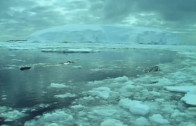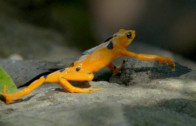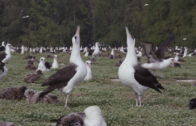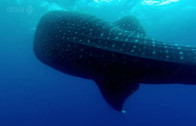Life In The Freezer
Life In The Freezer is a study of the seasonal cycle of Antarctica, exploring how different species survive throughout the course of a year.
Series
The first episode introduces the continent of Antarctica and the surrounding sea and islands, its glaciers and the icebergs that form from it. It describes how the continent changes throughout the seasons. Penguins, whales and seals are shown feeding in the Southern Ocean. Many of them eat the abundant krill (which in turn feed on phytoplankton and ice-algae). Humpback whales are shown catching krill through sophisticated co-operation: they create spiralling curtains of air bubbles that drive it into their centre, where the whales can then catch them by surging upwards in the middle of the spiral. Also shown are the various seabirds which feed in the Antarctic sea, especially albatrosses, whose impressive wingspans are possible because they utilise the updraft generated by the huge waves in the stormy southern waters. Because of the patchiness of krill, albatrosses can travel for many hundreds or indeed thousands of miles on a single trip in search of it. All birds scavenge, and a group (including giant petrels) is shown taking the remains of a whale, left by orca. Many birds (including penguins) lay their eggs and feed their chicks on the islands surrounding the Antarctic continent, especially South Georgia where both albatross and King penguins have their nesting sites throughout the year.
Part two examines what happens during spring on Antarctica. The sea ice extends for hundreds of miles around the continent, but there are a few subantarctic islands that escape it. Such places are highly valued, for as the sea never freezes, animals can always get ashore. Elephant seals are the first creatures to return to the beaches. They form large breeding colonies, where the males fight fierce battles to gain and retain permanent access to a great number of females and mate with them as soon as they are receptive again. Millions of macaroni penguins occupy huge territories on the islands to breed, as do thousands of albatrosses. The Antarctic peninsula is one of the few regions of the continent inhabited by animals, even in summer. Gentoo penguins build their nests on bare rock and humpback whales seek krill along the coast, while Adelie penguins nest even further south. Crabeater seals, one of the most numerous mammals on Earth, live and reproduce in the pack ice zone around Antarctica. Snow petrels fly many miles into the island to find rock on which to lay their eggs.
Turning to summer, part three documents the time when almost all life in Antarctica breeds. A South Georgian colony of fur seals is shown: the pups grow fast on the rich, fatty milk provided by their mothers and double their weight in just sixty days. As the females become sexually available, the mating season begins–males try to claim territory and mate with females. Chinstrap penguins form large groups on Deception Island, climbing up its steep slopes to find mountain ridges free of snow. Returning birds find their partners by recognising their voice. Males and females take turns in catching food, some of which they later regurgitate for their chicks. The summer also thaws some of the ice on the continent’s shores. The fresh water allows moss and other plants to grow, which in turn provide food for mites that are adapted to the cold climate–they can survive temperatures up to minus 30°C because they contain a kind of antifreeze. They become active as soon as the ice melts, and reproduce whenever they get an opportunity to do so. Lichens grow even further south than moss, and algae populate some of the snow. In the ocean, life is much more diverse, and blue-eyed shags dive for fish near the peninsula. More than 300,000 petrels come to breed to the Scullin Monolith, one of the few areas of open rock.
Part four describes the migration of most animals northwards (some from the Antarctic continent, others from the few islands surrounding it) as the continent and surrounding sea freeze over at the end of summer. At Cape Royds, the most southerly colony of Adelie penguins is virtually emptied as adults lead their newly feathered young to the sea. Young penguins often fall prey to leopard seals as they try to make their way across the already partially frozen water–and their stripped remains become food for isopods and meter-long nemerteans. However, before going to the sea, the adult penguins must moult their coats. The freezing sea ice usually does not reach South Georgia, and seal pups are still fed there by their mothers in autumn to be ready for the winter. They use their remaining time for play and mock fights in the ocean. Those who do not survive become food for the predator birds–the skuas and the giant petrels. Elephant seals also undergo moulting while on the island. Albatrosses nesting on South Georgia continue to feed and mate, but the ever harsher weather forces most animals further northwards.
Part five follows species who stay during the coldest weather. As almost all animal inhabitants of Antarctica are forced to migrate, the sea underneath the ice still provides a home to many specially adapted fish whose cells are protected from freezing through an inherent “antifreeze”. Many feed on the faeces of other animals. Perhaps the most notable larger creature that does not journey north is the Weddell seal, which can be found as close as 1300 kilometres to the pole. Groups of seals tear holes into the ice to dive for food and come up to breathe. The females come back to the ice to give birth. Also described is primitive plant life such as lichen, which can still be found on the continent in winter, even in the extremely dry and permanently frozen valleys–conditions under which dead animals can lie frozen for many centuries without decomposing.
The final instalment discusses human exploration of Antarctica, in particular the mission led by Captain Robert Falcon Scott, whose team died on the way back from the South Pole. Attenborough visits the hut at Cape Evans where Scott and his team spent the winter of 1911. It shows their well-equipped laboratory and the darkroom where the group’s photographer, Herbert Ponting, developed his films. Attenborough contrasts the transportation used by Scott (initially motor sledge, ponies and dogs before ending up on foot) with today’s helicopters. The episode also details the scientific work in the modern human bases in Antarctica, especially Mawson Base and its observation of Adelie penguins (partially through tracking devices). The film concludes that although working in Antarctica is now much easier than during the early days of exploration, human footsteps on the continent are still exceedingly rare–in part because of international treaties “prohibiting” industrial exploitation.




